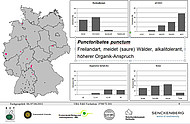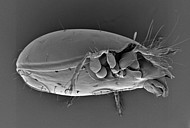Evaluation of soil biodiversity in Germany
In this project, funded by the German Federal Environment Agency (UBA) we compiled and analysed data on the soil status of permanent sites with regard to the implementation and advancement of the national strategy on biological diversity.
Background According to the German Federal Soil Protection Act (1998), one of the natural functions of the soil is its ability to act as a habitat for organisms (mainly invertebrates and microbes). So far, this function is not considered when assessing the quality of soils, e.g. in the context of landscape planning. The German National Strategy on Biological Diversity presents a vision regarding soil use: “Germany possesses a natural diversity of soils which have evolved over the course of history, are typical of the region, and fulfill a range of functions for man and nature. They offer favorable living conditions for the location-typical species and biotic communities which live in, on and from the soils. Our Aims: By supporting the natural functions, the correct functioning of soils is maintained in the long term. Good soil use practices make allowance for this fact. In consequence soil functions must be protected, e.g. the natural function of soil as one of the foundations of life for humans, animals, plants and soil organisms, as a component of the natural balance, and as a degradation, equalization and reconstruction medium for material influences by virtue of its filtering, buffering and substance conversion properties.” Aims of the project- Critical compilation of existing concepts and approaches in the area of biological soil classification and assessment;
- Assembly of a database on soil biodiversity in Germany, in particular collection of data from German Permanent Soil Monitoring Sites (BDF) and from literature (for Collembola, Oribatida, Lumbricidae, Enchytraeidae and microbes);
- Definition of a base-line for a soil organism inventory
- Expression of recommendations for the implementation of soil biological monitoring concepts and methods in Germany.
Selected Publications
- Jänsch S., Steffens L., Höfer H., Horak F., Roß-Nickoll M., Russell D., Toschki A., Römbke J. (2013):
-
State of knowledge of earthworm communities in German soils as a basis for biological soil quality.
Soil Organisms 85(3), Görlitz: 215-233

- Römbke J., Burkhardt U., Höfer H., Horak F., Jänsch S., Roß-Nickoll M., Russell D., Schmitt H. & Toschki A. (2013):
- Die Biodiversität als Instrument zur Beurteilung des Bodenzustands: Theoretischer Hintergrund, konzeptionelle Überlegungen und Empfehlungen. Bachmann G., König W. und Utermann J. Bodenschutz - Ergänzbares Handbuch der Maßnahmen und Empfehlungen für Schutz, Pflege und Sanierung von Böden, Landschaft und Grundwasser 1290, Berlin, Erich Schmidt Verlag: 1-76
- Römbke J., Burkhardt U., Höfer H., Jänsch S., Roß-Nickoll M., Russell D., Schmitt H., Toschki A. (2013):
-
Die Beurteilung der Boden-Biodiversität: Ergebnisse eines UBA-Vorhabens.
Bodenschutz 3: 100-105

- Römbke J., Jänsch S., Höfer H., Horak F., Roß-Nickoll M., Russell D., Toschki A. (2013):
-
State of knowledge of enchytraeid communities in German soils as a basis for biological soil quality assessment.
Soil Organims 85(2), Görlitz: 123-146

- Römbke J., Jänsch S., Roß-Nickoll M., Toschki A., Höfer H., Horak F., Russell D., Burkhardt, U., Schmitt H. (2012):
-
Anhang zu: Erfassung und Analyse des Bodenzustands im Hinblick auf die Umsetzung und Weiterentwicklung der Nationalen Biodiversitätsstrategie.
UBA Texte 34/2012, Dessau-Roßlau: 1-165

- Römbke J., Jänsch S., Roß-Nickoll M., Toschki A., Höfer H., Horak F., Russell D., Burkhardt, U., Schmitt H. (2012):
-
Erfassung und Analyse des Bodenzustands im Hinblick auf die Umsetzung und Weiterentwicklung der Nationalen Biodiversitätsstrategie.
UBA Texte 33/2012, Dessau-Roßlau: 1-386


Dr. Hubert Höfer, Dipl.-Biol.
Phone: +49 721 175 2826
E-Mail: hubert.hoefer[at]smnk.de









